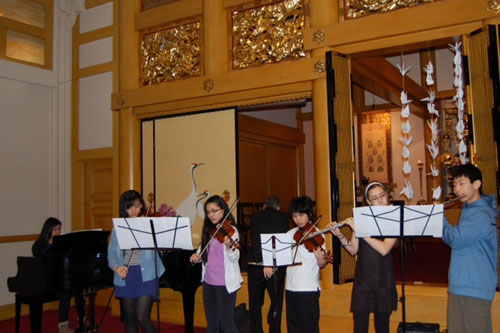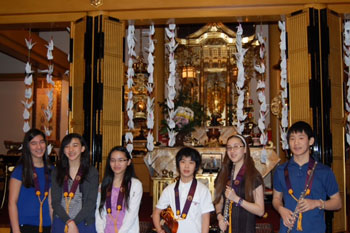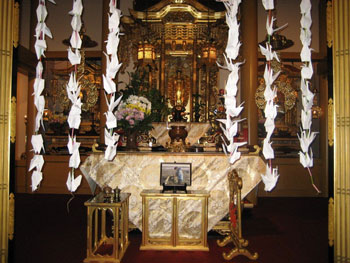
The Bodhi Ensemble played for the service.

Seattle Betsuin Honors One-Year Anniversary of Japan Earthquake
Ten strands of white paper cranes dangled from the front of the shrine. “Cranes represent fidelity and long life,” said Seattle Buddhist Temple Rinban (head minister) Don Castro. “White symbolizes death. Without death there is no life. Today we’re honoring those who died one year ago today.”
He added, “On the spring equinox we celebrate the six paramitas, or perfections. The first paramita is selfless giving. As of November, the Buddhist Churches of America organization has sent $1.4 million to Japan, and today our high school students are collecting donations of rice for Northwest Harvest.”
With these words, the temple’s one-year memorial service for victims of the Japanese earthquake/tsunami began. (Traditionally, Jodo Shinshu Buddhists hold memorial services once a week for seven weeks after death and then one, three, and seven years later, continuing five more times until year 50, though the practice itself is declining.)
The service chair reminded us that on March 11, 2011, at 2:46 p.m., Japan experienced an earthquake of 9.0, followed by tsunami waves thrusting as high as 133 feet in the air. About 20,000 people are considered dead or missing.
For newcomers attending this service, the presence of pews, ministers, a choir, musicians and a dharma talk (sermon) might create the illusion that they are in a Christian church. But the chanting, reciting of the three treasures — (“I take refuge in the Buddha, dharma (the teachings) and sangha” (the community of Buddhist practitioners), and the quotes from our sect’s founder, Shinran Shonin, tell a different story.
Guest minister Rev. Dr. Kenji Akahoshi began his dharma talk by asking the sangha to sit in silent meditation for one minute, placing themselves “in the lives of those in that area of Japan. Imagine yourself one day before the earthquake, on the day of destruction, and the following day. Do you feel a oneness with the people in that area?”

The Bodhi Ensemble.
Akahoshi noted, as news commentators did this time last year, that, “The reaction and response of the people of Japan — especially the sense of community — was viewed by the rest of the world as extraordinary.”
He said he believes that the culture of interconnectedness rises from the influence of Buddhism in Japan. He said, “So many of the principles of Buddhism have been incorporated into the culture and language of Japan over the centuries that it is a natural way of living, of being.”
“As an example,” he said, referring to American culture, “Let’s look at how we normally greet each other.”
“How are you?”
“I am fine.”
“The point is that we take all the credit.
“When Japanese greet each other, the response is, ‘Okagesama de. Because of you and other causes and conditions that support me, I am fine,’” he said. “Throughout the day, as people meet each other, they are affirming the reality that they are interconnected. Don’t you think that this constant reminder, expressed every time two or more people meet, has been the source of people helping people, sharing food, clothing and shelter in an orderly manner?
He continued, “When the earthquake struck, Japanese said, ‘Shikataganai. It can’t be helped,’ meaning that despite our best efforts bad things happen and we must accept them. This represents a deep understanding of the Buddha’s first Noble Truth: there is suffering in life. The ability of the Japanese to recover, whether it be from World War II, years spent in internment camps in the U.S, or from the earthquake/tsunami, is based on another belief, which is summed up in the third Noble Truth: It’s possible for suffering to end.
“The Japanese are able to find a balance between suffering and the extinction of suffering based on how they view the world. Most of us engage in selective seeing and hearing. We can identify things that don’t work as well as they might. We carry a mindset of ‘please,’ which suggests we want something we don’t have, or we want to see improvements, we want to get better. In Japan they focus on ‘thank you,’ which speaks to gratefulness for what we have. I invite you to shift your inner view to thank you.
“Shin Buddhists have a practice, though it is not meditation or following a set of monastic rules. This practice is not to achieve anything or get anywhere. The practice is appreciating what is. When we say, Namo Amida Butsu, we are acknowledging that we are awake to the gifts of life that we have received from all beings, human or otherwise. It affirms that we are okay even when negative events impact our lives.

Naijin Shrine.
“The way to develop this practice of gratitude is to experience it a little bit every day. This is especially helpful for newcomers to Shin Buddhism and younger generation Shin Buddhists who don’t yet live it naturally or unconsciously. Once a day, find something to be thankful for. Develop a habit to remind yourself of things for which you have been grateful. Then, after a few days or weeks, extend that to three things a day. That might be just saying thank you at mealtimes: ‘Itadakimasu. I humbly receive this.’
“The introduction to the Three Treasures — ‘Rare is it to be born in human life. More rare is it for us to hear the teachings of the Buddha’ — reinforces the importance of appreciating this singular, unique human life. At the end of our lives, will we be saying, ‘Please, one more day, one more month, one more year? Or will we say, ‘Thank you for this last year, this last month, this last day.’”
The dharma talk was over, but it left us much to think about in the coming weeks. The service chair read “A Thousand Winds,” which has been translated into Japanese as Sen No Kaze Nitta, and put to music. The choir sang it earlier today.
Do not stand at my grave and weep
I am not there; I do not sleep.
I am a thousand winds that blow,
I am the diamond glints on snow,
I am the sun on ripened grain,
I am the gentle autumn rain.
When you awaken in the morning's hush
I am the swift uplifting rush
Of quiet birds in circled flight.
I am the soft stars that shine at night.
Do not stand at my grave and cry,
I am not there; I did not die.
We put our palms together and said, “Namu Amida Butsu.”
Author: Ann Oxrieder is webmaster, publicity volunteer and a member of Seattle Betsuin Buddhist Temple in Seattle.
Photos: Don Castro, Mae Yamasaki